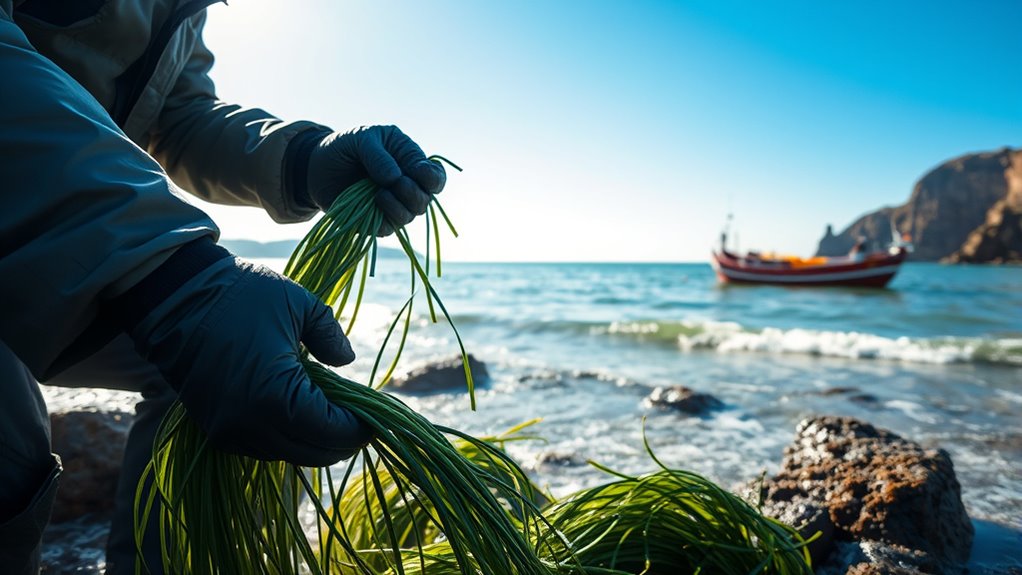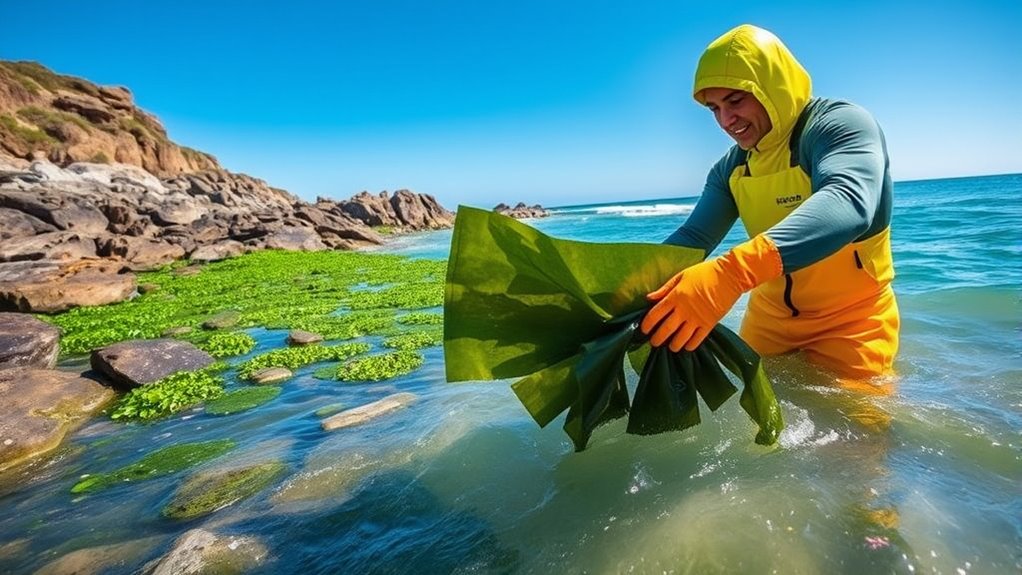To quickly gather wild nori sheets safely, approach the shoreline during low tide and look for healthy, vibrant patches on rocks or submerged surfaces. Wear gloves and use scissors or a knife to carefully cut the seaweed at its base, avoiding damage to the plant or habitat. Rinse your harvest thoroughly, check for signs of decay, and follow local regulations for sustainable collection. Keep these tips in mind to harvest responsibly and enjoy fresh nori—there’s more to discover if you continue exploring.
Key Takeaways
- Approach shoreline during low tide to access healthy, fresh nori on rocks or submerged surfaces.
- Wear gloves and use scissors or a knife to carefully cut nori at its base, avoiding damage.
- Select vibrant, green or dark purple seaweed, avoiding brown, slimy, or damaged specimens.
- Rinse harvested nori thoroughly with fresh water to remove sand, salt, and debris.
- Follow local regulations and sustainable practices to protect the environment and ensure future foraging success.

Gathering wild nori sheets is a rewarding activity that connects you directly with nature’s bounty. As you prepare for your foraging adventure, it’s essential to prioritize harvesting safety. This means understanding the environment you’re entering and respecting the local ecosystem. Always wear gloves to protect your hands from sharp edges and possible irritants. Carry scissors or a sharp knife to carefully cut the nori at the base, avoiding unnecessary damage to the surrounding seaweed and marine life. Before you start, make sure you’re familiar with local regulations; many coastal areas have rules to prevent overharvesting and protect marine environments. By adhering to these guidelines, you contribute to sustainable practices that ensure wild nori populations remain healthy for future foragers and marine life alike.
When you approach the shoreline, look for lush, vibrant patches of nori growing on rocks or submerged surfaces. The best time to harvest is during low tide when the seaweed is most accessible and at its peak freshness. Be gentle as you work; pulling or tearing the seaweed can damage the plant and disrupt the surrounding habitat. Instead, use your scissors or knife to carefully cut the nori at its base, leaving enough behind to allow the plant to regrow naturally. This sustainable practice helps maintain the health of the seaweed beds, ensuring that your harvest doesn’t deplete the resource or harm the ecosystem. Ensuring the seaweed’s freshness and quality is crucial for a safe and tasty harvest.
As you gather the sheets, check for signs of disease or decay. Only collect healthy, vibrant green or dark purple nori, avoiding anything that looks brown, slimy, or damaged. This attention to harvesting safety not only ensures you’re getting quality ingredients but also reduces the risk of bringing home spoiled or contaminated seaweed. Once collected, rinse the nori thoroughly with fresh water to remove any sand, salt, or debris. Proper cleaning is part of responsible harvesting that minimizes environmental impact and keeps your foraged seaweed safe for consumption.
Frequently Asked Questions
Is It Legal to Harvest Wild Nori in All Coastal Areas?
You should check local coastal regulations before harvesting wild nori, as legal considerations vary by area. In some regions, gathering is permitted for personal use, while others require permits or prohibit collection altogether. Always guarantee you’re following specific rules to avoid fines or legal trouble. Understanding these coastal regulations helps you harvest sustainably and responsibly, ensuring the health of marine ecosystems and enjoying your foraging experience without issues.
What Are the Best Seasons for Wild Nori Collection?
You might think nori grows year-round, but ironically, the best seasons for wild nori collection are during specific harvesting windows tied to seasonal growth. Usually, late spring to early summer offers ideal conditions, when the sea’s nutrients boost nori’s quality. During these times, you can gather fresh, healthy sheets safely. Ignoring these seasons means missing out on prime nori and risking poor quality or overharvesting. So, plan your harvest accordingly!
How Do I Identify Authentic Wild Nori From Look-Alikes?
To identify authentic wild nori from look-alikes, focus on seaweed differentiation. Look for thin, dark green to black sheets with a slightly rough texture and a distinctive aroma. Authentic wild nori usually has a uniform shape and size, unlike look-alikes that may be irregular or thicker. Check for the natural, glossy appearance and avoid seaweed with artificial coatings or unusual colors, ensuring you’re gathering genuine wild nori.
Are There Any Health Risks Associated With Wild Nori Consumption?
You wonder if wild nori is safe to eat. While it’s a delicious, nutritious choice, you should be aware of potential health risks like pesticide contamination and allergen concerns. Wild nori may absorb pollutants from the environment, so testing or sourcing from clean areas is wise. Also, if you have allergies to seaweed, consuming wild nori could trigger reactions. Stay informed, practice moderation, and enjoy your foraged bounty responsibly.
Do I Need Special Permits or Permissions to Gather Wild Nori?
You should check local harvesting regulations and permission requirements before gathering wild nori. Many areas have rules to protect marine ecosystems, so you might need a permit or special permission. Failing to follow these regulations could lead to fines or environmental harm. To stay safe and legal, contact local authorities or marine resource agencies to understand the specific harvesting restrictions in your area.
Conclusion
Now that you know how to gather wild nori sheets safely, you’re like a skilled sailor steering a calm sea, harvesting treasures from beneath the waves. With each careful step, you bring home a bounty of the ocean’s goodness, turning a simple act into a rewarding adventure. So, go ahead—embrace the rhythm of the tide, and let your newfound knowledge lead you to a flavorful, sustainable harvest that’s as natural as the ocean breeze.










